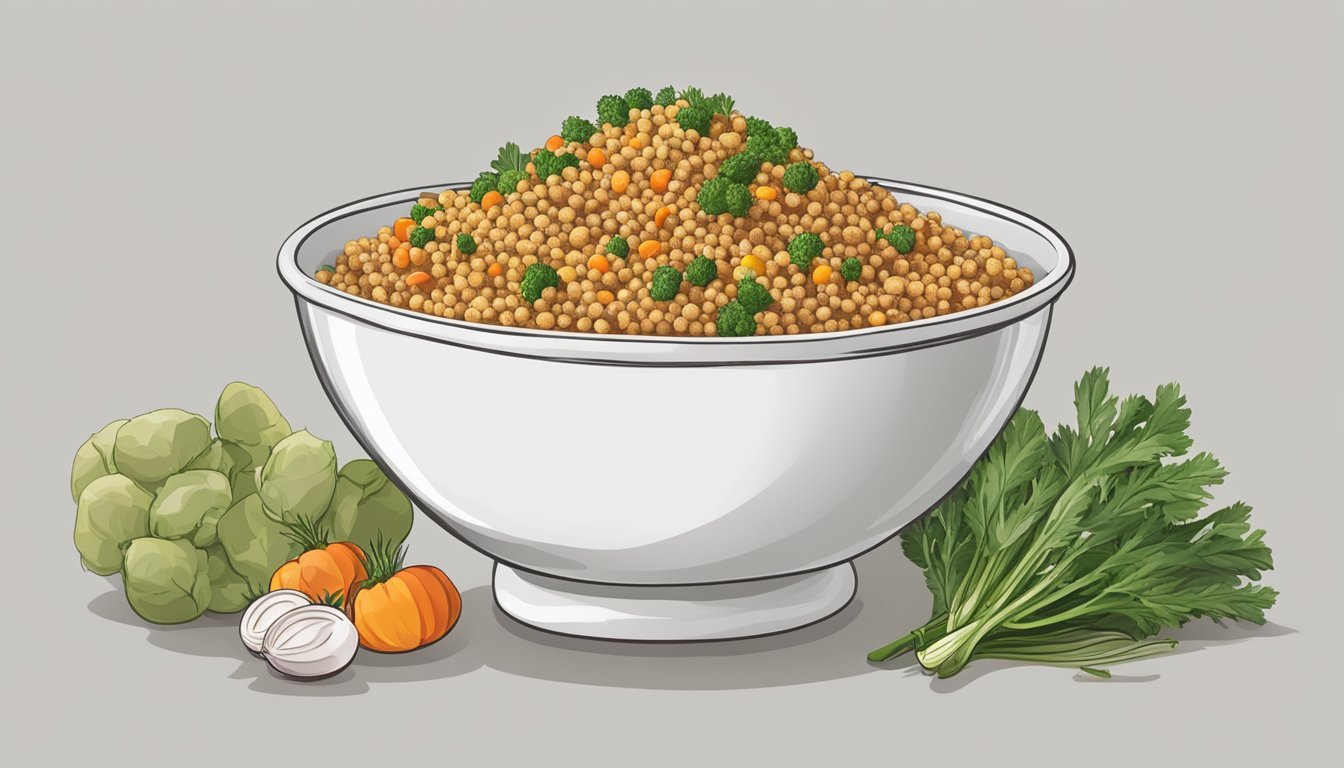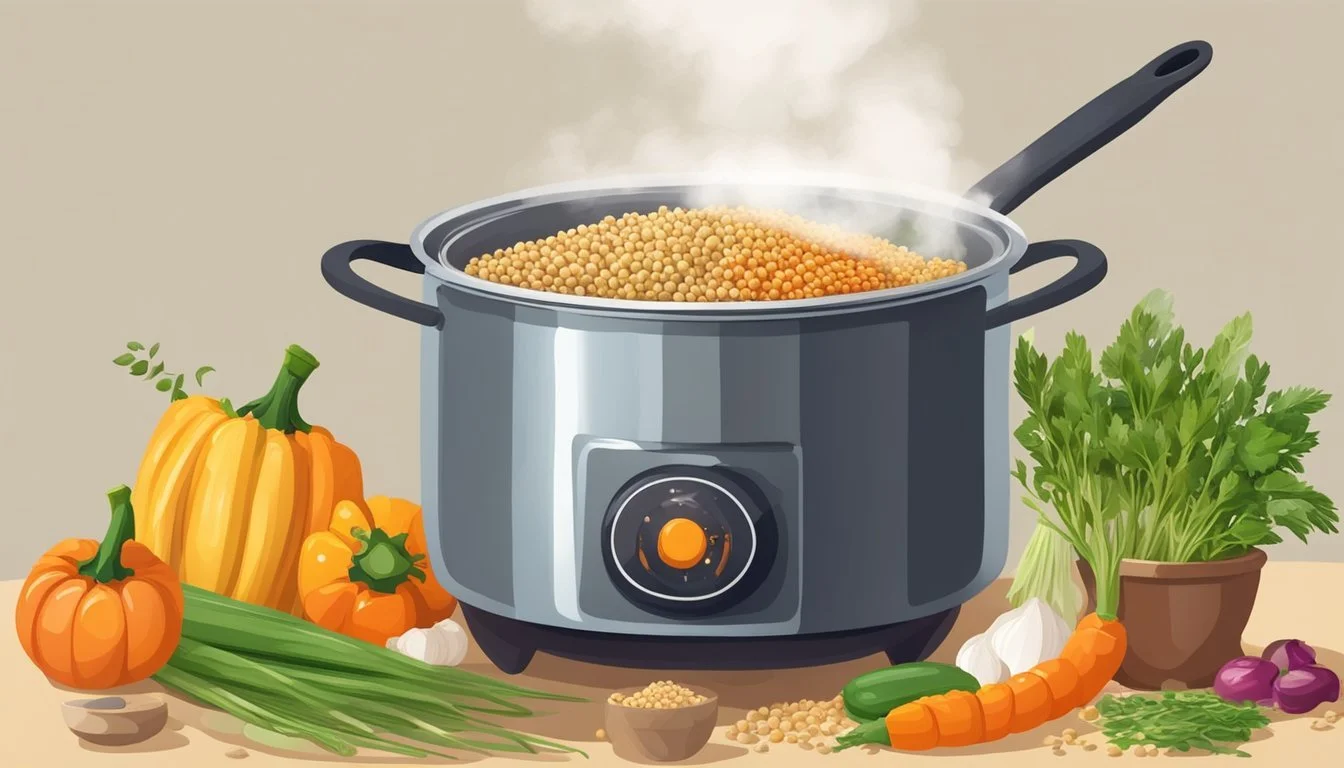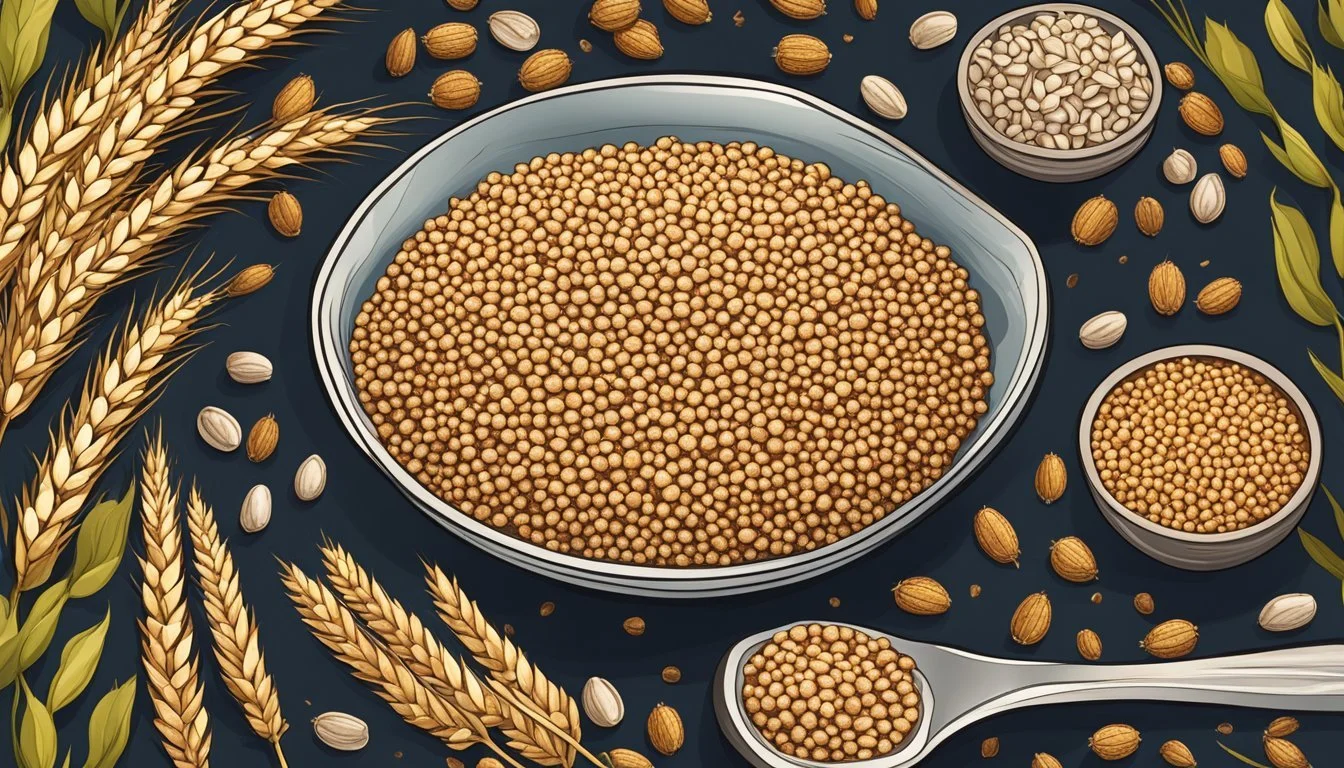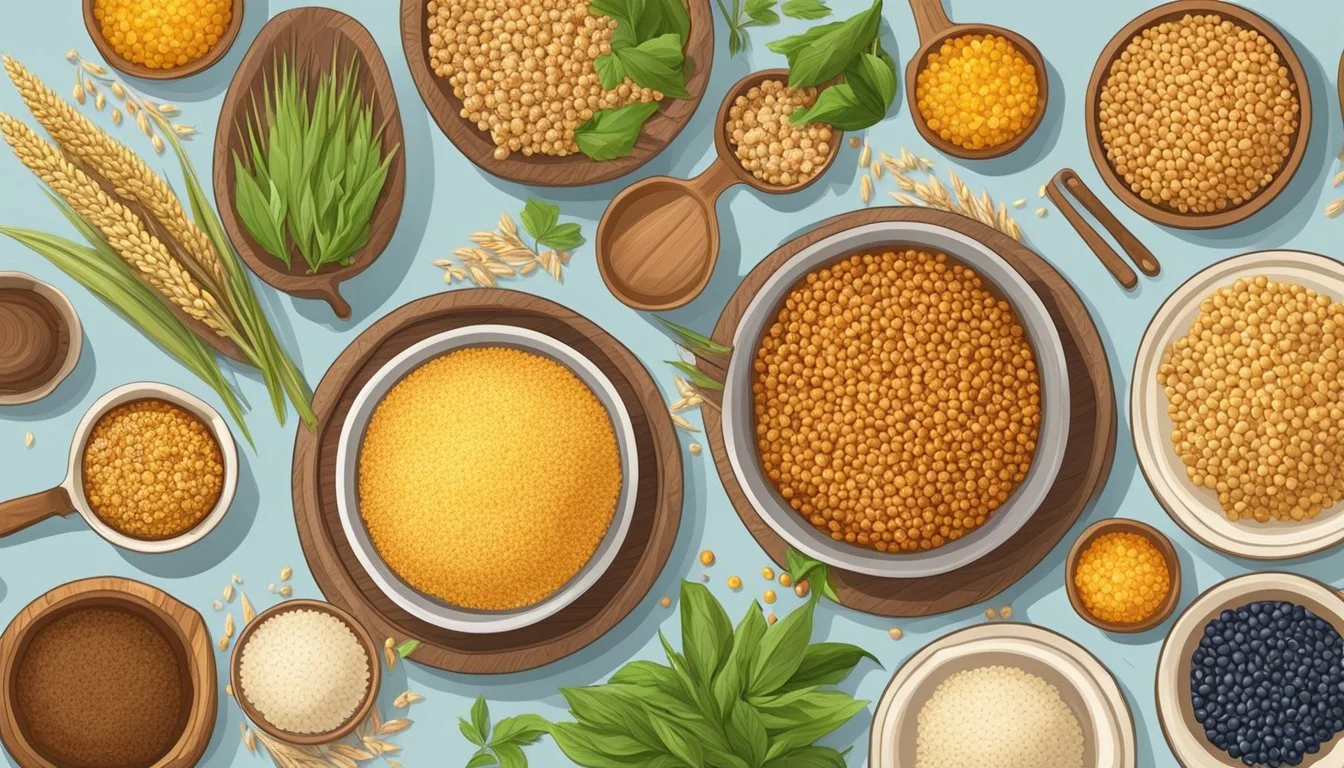Saving Overcooked Sorghum
Tips to Salvage and Enhance Your Grain Dishes
Sorghum, an ancient grain long cherished for its nutritional benefits and sustainability, often falls prey to overcooking—a mishap that can transform its naturally tender texture into something less desirable. However, there's a silver lining to every culinary cloud. There are several techniques one can employ to salvage overcooked sorghum, ensuring that none of its nutritive value goes to waste. Rich in protein and fiber, sorghum is an excellent choice for those seeking a nutritious alternative to wheat, given its gluten-free properties.
The versatility of sorghum is one of its strengths, as this resilient crop can easily be integrated into a variety of dishes. Whether overcooked sorghum finds new life in a hearty stew, which can forgive its softer texture, or becomes the base for a flavorful salad with a binding dressing that masks any mushiness, the grain's adaptability is a saving grace. What's more, its mild and slightly sweet flavor profile allows it to seamlessly blend with an array of ingredients, further enhancing its usability in the kitchen.
Given sorghum's status as an eco-friendly crop, it's no surprise that finding ways to save overcooked grains aligns with a sustainable approach to cooking. In addition to being resource-efficient in its cultivation, making the most of every sorghum serving is a conscious effort to reduce waste. The nutritionally dense nature of this ancient grain makes it an ally in healthy eating and a cherished staple in pantries worldwide. With a little creativity and know-how, even overcooked sorghum can be transformed into a dish that is both delicious and nourishing.
The Importance of Sorghum as an Ancient Grain
Sorghum stands out as a significant ancient grain with a substantial impact on global nutrition. It serves as a dietary staple, especially in parts of Africa, India, and China. Recognized for its resilience, sorghum thrives in arid and semi-arid regions, ensuring food security for populations in these climates.
This ancient grain is valued for its nutritional profile. Naturally gluten-free, sorghum is an inclusive food option for those with gluten intolerances or celiac disease. Its composition is as follows:
Protein: Essential for body repair and growth
Fiber: Beneficial for digestion and satiety
Listed as one of the select whole grains recommended by the United Sorghum Checkoff Program, sorghum is a versatile addition to a balanced diet. Not only is it a nutritious choice, but incorporating whole grains like sorghum is linked to lower risks of chronic diseases.
The popularity of sorghum is not just historical but also current, as its benefits are recognized in modern diets. Its cultivation respects the environment due to lower water and resource requirements, which is increasingly vital in today's climate-aware society.
Overall, sorghum's significance reaches beyond its role as a staple food. It encapsulates ancient wisdom through its enduring relevance in nutrition, culinary use, and sustainable agriculture.
Nutritional Profile of Sorghum
Sorghum, a nutritious whole grain, offers a robust profile packed with essential protein, fiber, vitamins, and minerals. Recognized for its health-promoting phytochemicals, sorghum is a versatile food source with evidence pointing towards numerous health benefits.
Vitamins and Minerals in Sorghum
Sorghum contains a variety of vitamins and minerals that are crucial for maintaining good health. The grain is a good source of magnesium, which is vital for many bodily functions, and iron, which is essential for blood production and the prevention of anemia. Other minerals present in sorghum include calcium, important for bone health; zinc, which supports the immune system; and copper, necessary for iron absorption and enzyme function.
Iron: Key in the prevention of anemia and production of hemoglobin
Magnesium: Supports muscle and nerve function, blood glucose control, and blood pressure regulation
Calcium: Essential for bone strength and function
Zinc: Crucial for immune function, wound healing, and DNA synthesis
Copper: Important for the utilization of iron and overall cardiovascular health
Sorghum's Protein and Fiber Content
As a whole grain, sorghum is rich in protein, making it an excellent dietary option for protein supply. Moreover, the fiber content in sorghum contributes significantly to digestive health, with the added advantage of aiding in blood sugar control. This combination makes it particularly beneficial for individuals managing diabetes.
Protein: Vital for building and repairing tissues, manufacturing enzymes and hormones
Fiber: Essential for healthy digestion and keeping blood sugar levels stable
Health Benefits of Sorghum
The health benefits of sorghum are multi-faceted, thanks in part to its content of antioxidants, phytochemicals like anthocyanins and phenols. These compounds can help reduce oxidative stress, thus potentially lowering the risk for chronic diseases such as cancer.
Antioxidants and Phytochemicals: Help protect cells from damage
Anthocyanins and Phenols: May lower inflammation and reduce cancer risk
Culinary Applications of Sorghum
Sorghum, a nutritious ancient grain, demonstrates considerable versatility in cooking, lending itself to various dishes from traditional to contemporary kitchens. It adapts well to numerous culinary styles and can replace many common grains.
Sorghum in Traditional Dishes
Traditionally, sorghum forms the cornerstone of certain regional diets, appreciated for both its hardiness as a crop and its nutritive qualities. In Africa and parts of Asia, sorghum is a primary ingredient in various porridges and flatbreads. For example:
Bhakri jowar: An Indian flatbread made from sorghum flour.
Porridges: A staple breakfast option in many cultures, cooked from ground or whole sorghum.
Modern Recipes Featuring Sorghum
With the global interest in ancient grains, sorghum has entered the contemporary culinary scene. Chefs and home cooks alike incorporate sorghum into modern dishes, valuing it for its nutritional content and mild flavor. Some current applications include:
Salads: Sorghum grains add a chewy texture, making it a substitute for quinoa or couscous (What wine goes well with couscous?).
Cereals and Cakes: Sorghum flour serves as a gluten-free option in baking.
Modern chefs may also pop sorghum much like popcorn, as a healthy, fiber-rich snack.
Sorghum as a Substitute for Other Grains
Sorghum can effortlessly replace grains like rice, wheat, and millets in recipes due to its mild taste and nutritional profile:
Rice Substitute: In any dish that traditionally uses rice, from pilafs to stir-fries.
Wheat Alternative: Sorghum flour proves useful in gluten-free breads and sauces.
Quinoa or Couscous: Sorghum's similar size and versatility make it an ideal swap in salads or side dishes where these grains might be used.
To cook sorghum as a side dish or base for other components:
Measure Water Sorghum Time 1 cup 3 cups 1 cup 45-60 minutes
Using precise ratios and cooking times ensures sorghum retains its chewy texture, avoiding overcooking. It absorbs flavors well, making it an adaptable ingredient for a wide range of recipes.
Cooking Techniques for Sorghum
Sorghum's culinary versatility allows it to be transformed into everything from hearty porridge to a satisfying substitute for brown rice. Utilizing proper cooking techniques helps ensure a tender texture, preventing the grain from becoming overly soft or hard.
Preventing and Correcting Overcooking
To prevent overcooking, always start by measuring sorghum and water using a ratio of 1 cup of sorghum to about 3 cups of water. Bringing the water to a boil and then simmering it covered allows the grains to cook evenly. If sorghum has been overcooked, it can be spread on a baking sheet and placed in a warm oven to dry out the grains, making them easier to salvage for dishes like salads where a firmer texture is preferred.
Diverse Methods for Preparing Sorghum
Sorghum can be prepared using various methods, each offering a different texture and flavor profile to dishes:
Stovetop: Simmer sorghum in boiling water for about 45-60 minutes.
Pressure Cooker: Quick and efficient, cook sorghum with water at high pressure for around 12 minutes.
Rinse and Repeat: Remember to wash and rinse sorghum thoroughly before cooking to remove any debris.
Creating Tender and Flavorful Sorghum Dishes
Creating dishes with sorghum involves more than just boiling the grains; flavor can be infused at every step. Consider using broth or stock instead of water to add a savory depth. For a rich, nutty flavor and a pop of texture, toast the sorghum grains in a dry skillet before cooking. Cooked sorghum can be stirred into soups and stews, offering whole grains that absorb flavors and contribute to the dish’s nutrients.
Note on Porridge: When making a sorghum porridge, a longer cooking time will be necessary to achieve the creamy consistency, with frequent stirring to prevent sticking and clumping. Adding milk (dairy or plant-based), spices, and sweeteners like honey or maple syrup can elevate a simple porridge to a comforting breakfast.
Gluten-Free Sorghum for Dietary Needs
Sorghum stands out as a gluten-free ancient grain that caters to diverse dietary needs. It is a safe choice for individuals with celiac disease or gluten sensitivities, as it does not contain gluten, unlike wheat, barley, or rye.
This whole grain is not only a versatile culinary ingredient but also packs a robust nutrition profile. Rich in important vitamins and minerals, sorghum offers benefits such as B vitamins, magnesium, potassium, and iron. Its high fiber content is favorable for heart health, aligning with recommendations from health organizations to include a range of whole grains as part of a balanced diet.
As a dietary staple, sorghum can be introduced into meals in various forms - from flour for baking to whole or cracked grains for pilafs and salads. However, when purchasing sorghum, it is crucial to ensure the product is labeled gluten-free to avoid the risk of cross-contamination with gluten-containing grains, especially if it is a necessity for health reasons.
Precautionary Measures:
Look for certified gluten-free labels.
Avoid bulk bins to reduce cross-contact risks.
In summary, sorghum serves as a beneficial and nutritious option for those requiring or choosing a gluten-free diet. It provides an opportunity to enjoy a wholesome grain without the concern of gluten, while contributing to a varied and nutrient-dense meal plan.
Sorghum in the Global Market
Sorghum, a resilient and drought-tolerant grain, has been a staple crop across many parts of the globe. Its adaptability to harsh climates makes it vital in regions where food security is at risk due to climate change. In the global market, sorghum primarily supports populations in sub-Saharan Africa, India, and China.
The grain's versatility is recognized by entities such as the Whole Grains Council, which promotes its use as a nutritious alternative to other cereals. As a gluten-free option, sorghum gains attention from health-conscious consumers and those with dietary restrictions.
Region Role in Sorghum Market Africa Largest producer and consumer India and China Significant production growth
Trade and market analysis reveal fluctuations in sorghum production volumes. For instance, production saw a decrease from 66.0 million tons in the period from 2014 to 2016 to 59.3 million tons in 2018, influenced by yield variations in developed regions. Despite these shifts, sorghum consistently finds its way onto the shelves of whole foods and general markets due to the growing popularity of whole grains.
Forecasts suggest a compound annual growth rate (CAGR) of approximately 4.43% for the sorghum market moving towards 2028. Such growth indicates rising demand for sorghum in various sectors, including human food consumption, animal feed, and biofuel production, reflecting its expanding role in the global market.
Overall, the global presence of sorghum is indicative of a grain that not only aligns with modern dietary trends but also serves as an economic cornerstone for communities dependent on agriculture.
Environmental Impact and Sustainability of Sorghum
Sorghum is highly regarded in sustainable agriculture for its minimal environmental impact. As a carbon-efficient crop, sorghum captures carbon effectively, contributing to lowering atmospheric CO2 levels.
Drought Resistance:
Sorghum exhibits remarkable drought tolerance, enabling it to thrive where other grains might fail.
Its deep root system allows efficient water utilization, thus conserving water resources.
The plant's resilience reduces the reliability on irrigation, a vital aspect in water-scarce regions.
Agricultural Benefits:
Farmers value grain sorghum for its adaptability to diverse climates and soils.
It offers flexibility in crop rotation, which is beneficial for soil health.
Sorghum adds to farm biodiversity, which can suppress pests and diseases.
Plant Utilization:
Beyond grain, sorghum's stalks and leaves serve as fodder, improving the farm's overall productivity.
Various parts of the plant can be used, which means less waste and a fuller use of resources.
Sorghum Varieties:
Breeding efforts have led to an array of varieties, each suited to specific climates and purposes.
Some sorghum varieties are grown specifically for their biomass potential in sustainable agriculture.
Incorporating sorghum into farming systems offers a promising avenue for enhancing sustainability in agriculture. Its ability to grow under challenging conditions while maintaining productivity showcases its role in a future of resilient food systems.
The Future of Sorghum: Trends and Developments
As the world increasingly seeks sustainable and nutrient-dense food sources, sorghum stands out as a grain of the future. It is established as a modern grain with potential due to its adaptability to diverse climates and soil conditions. Sorghum's growth trends show a rising trajectory in popularity and market presence.
Grain Boom and Sustainability
Sorghum is at the heart of a 'grain boom,' catering to the demands of both developing and developed nations. It requires significantly less water than other popular grains, making it an attractive option for areas facing water scarcity. Furthermore, sorghum's resilience to climate variability positions it well in the context of global climate change concerns.
Nutritional Appeal
Nutritionally, sorghum is rich in antioxidants and high in fiber, protein, and essential minerals. These attributes contribute to its increasing use as a health-conscious alternative to traditional grains.
Market Potential
Region Impact Africa Staple food, enhancing food security Americas Expansion into health foods and snacks Asia Growth due to adaptability to climate
Sorghum's popularity in various markets is bolstered by its versatility. It is used in a wide array of products from animal feed to gluten-free foods. Innovations in food science are expanding its use into new domains, such as biodegradable packaging and high-energy food products.
Concluding Thought
Research into sorghum genetics and genomics signals a tendency towards more productive and robust strains, situating sorghum as a leading crop that could address future food security and sustainability concerns. Recognizing sorghum's potential, global investments in breeding and technology are set to further enhance its appeal and applications.
Comparing Sorghum with Other Grains
Sorghum holds its own as a versatile and nutrient-packed grain amongst both ancient and modern grains. Here's how it stacks up against its contemporaries.
Sorghum vs. Wheat and Rye
Sorghum is naturally gluten-free, which sets it apart from wheat and rye, making it a suitable grain for those with gluten sensitivities. In terms of nutrition, sorghum boasts a higher fiber content compared to wheat, with about 8 grams of fiber per quarter-cup serving. Both wheat and rye are traditional grains that have been cultivated for millennia, but they contain gluten, which can be problematic for individuals with celiac disease or gluten intolerance.
Wheat Rye Sorghum Good source of protein High in fiber High in protein and fiber Contains gluten Contains gluten Gluten-free Widely used in baking Distinct flavor for breads Versatile in cooking (salads, side dishes)
Alternative Grains: Quinoa, Millets, and More
When compared to quinoa, another gluten-free ancient grain, sorghum is similar in its complete protein profile, although quinoa is often highlighted for its slightly higher protein content. However, sorghum is often more accessible and can be grown in harsher climates. Millets, which include a variety of small-seeded grains such as buckwheat, amaranth, teff, farro, kamut, and bulgur, tend to be rich in nutrients, though sorghum often leads with its antioxidant profile.
Other grains like barley and rice are modern staples with notable health benefits; still, sorghum's versatility and nutrient density make it a strong competitor. Whether it's whole grains like rice and barley, that are ingrained in our diets, or more niche grains like kamut and teff, they each have their own beneficial properties. Yet, sorghum remains a resilient, nutritious choice for a diverse diet.
Quinoa Millets Sorghum Higher protein content Variety of nutrients Rich in antioxidants Gluten-free Gluten-free options Gluten-free and accessible Adaptable to many recipes Various culinary uses Drought-resistant grain
Frequently Asked Questions About Sorghum
This section addresses common inquiries regarding the health benefits and culinary uses of sorghum. These questions often revolve around sorghum's nutritional value and its versatility in recipes.
Health and Nutritional Queries
What are the health benefits of including sorghum in one's diet?
Protein Content: Sorghum provides about 5 grams of protein per 1/4-cup serving, making it a substantial source of this essential macronutrient.
Fiber-Rich: With approximately 8 grams of fiber per serving, it supports digestive health.
Gluten-Free: Sorghum is naturally gluten-free, suitable for those with celiac disease or gluten sensitivity.
Can sorghum be part of a healthy diet? Certainly. It's not only a good source of protein and fiber but also contributes phytochemicals that may offer additional health benefits.
Culinary and Cooking Concerns
How is sorghum cooked for the best results?
Rinsing: Start by rinsing sorghum under cool water using a fine-mesh strainer.
Water to Grain Ratio: Combine 1 cup dried sorghum with 3 cups of water, and bring to a boil.
Cooking Time: Reduce the heat and simmer for approximately 45-50 minutes or until tender.
What are some recipe ideas using sorghum?
Breakfast Cereals: Sorghum can be used similarly to oats in hot breakfast cereals. Top with fruit and nuts for a nutritious start to the day.
Breads: Sorghum flour is an excellent gluten-free option for baking breads.
Soups and Stews: Add cooked sorghum to soups, stews, or chilies for an extra nutritional punch.
Conclusion
Sorghum stands out as a resilient and versatile ancient grain, an asset to both nutrition and the environment. When overcooked, one need not discard this nutritious food; they can embrace its tender quality in various dishes.
For Nutrition: Sorghum is a nutritional powerhouse, offering protein, fiber, and a range of phytochemicals beneficial to health. One can enhance their diet by incorporating this grain, even if it has been overcooked, by adding it to soups or pureeing it for a nutritious base in recipes.
Environmental Benefits: The environmental sustainability of sorghum is noteworthy. It thrives with minimal water, making it a staple for future trends in eco-friendly agriculture. This drought-tolerant crop can be a key player in global food security as water resources become increasingly scarce.
Culinary Adaptability: The diversity of sorghum in cuisine is significant. Overcooked grains can be transformed into a creamy risotto-like dish or incorporated into stews and casseroles. Its mild flavor allows it to easily adapt to various flavor profiles.
Global Impact: Sorghum's role in feeding populations cannot be overstated. It is a staple grain for millions, with a growing presence in food economies around the world. Its adaptability to climate change positions sorghum as a grain of the future.
With its nutritional benefits, environmental resilience, and culinary versatility, sorghum will undoubtedly continue to be a valued grain in both local and global contexts. Chefs and home cooks alike can look to sorghum as a dependable ingredient that supports both the planet and the people.











